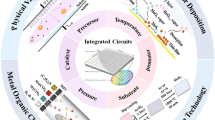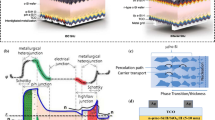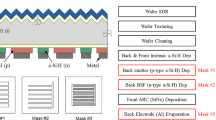Abstract
One challenge to the use of lightly-doped, high efficiency emitters on multicrystalline silicon wafers is the poor gettering efficiency of the diffusion processes used to fabricate them. With the photovoltaic industry highly reliant on heavily doped phosphorus diffusions as a source of gettering, the transition to selective emitter structures would require new alternative methods of impurity extraction. In this paper, a novel laser based method for gettering is investigated for its impact on commercially available silicon wafers used in the manufacturing of solar cells. Direct comparisons between laser enhanced gettering (LasEG) and lightly-doped emitter diffusion gettering demonstrate a 45% absolute improvement in bulk minority carrier lifetime when using the laser process. Although grain boundaries can be effective gettering sites in multicrystalline wafers, laser processing can substantially improve the performance of both grain boundary sites and intra-grain regions. This improvement is correlated with a factor of 6 further decrease in interstitial iron concentrations. The removal of such impurities from multicrystalline wafers using the laser process can result in intra-grain enhancements in implied open-circuit voltage of up to 40 mV. In instances where specific dopant profiles are required for a diffusion on one surface of a solar cell, and the diffusion process does not enable effective gettering, LasEG may enable improved gettering during the diffusion process.
Similar content being viewed by others
References
International Technology Roadmap for Photovoltaic (ITRPV). International Technology Roadmap for Photovoltaic Results 2015, 7th edition. Frankfurt. 2016, http://www.itrpv.net
Weber E. Transition metals in silicon. Applied Physics A, Materials Science & Processing, 1983, 30(1): 1–22
Cuevas A, Macdonald D, Kerr M, Samundsett C, Sloan A, Shea S, Leo A, mrcarica M, Winderbaum S. Evidence of impurity gettering by industrial phosphorus diffusion. In: IEEE 28th Photovoltaic Specialists Conference (PVSC). 2000: 244–247
Khedher N, Hajji M, Hassen M, Ben Jaballah A, Ouertani B, Ezzaouia H, Bessais B, Selmi A, Bennaceur R. Gettering impurities from crystalline silicon by phosphorus diffusion using a porous silicon layer. Solar Energy Materials and Solar Cells, 2005, 87(1–4): 605–611
Bentzen A, Holt A, Kopecek R, Stokkan G, Christensen J, Svensson G. Gettering of transition metal impurities during phosphorus emitter diffusion in multicrystalline silicon solar cell processing. Journal of Applied Physics, 2006, 99(9): 093509
Mayandi J, Marstein E S, Syre M, Olaisen B R, Thomassen B, Holt A, Vines L. The effect of P concentration on gettering of multicrystalline Si wafers. European Photovoltaic Solar Energy Conference (EU PVSEC), Hamburg, Germany, 2009, 2160–2163
Phang S, Macdonald D. Effect of boron codoping and phosphorus concentration on phosphorus diffusion gettering. In: 2014 IEEE 40th Photovoltaics Specialist Conference (PVSC). Denver, USA, 2014, 64–69
Hahn G, Joos S. State-of-the-art industrial crystalline silicon solar cells. In: Willeke G P, Weber F R, ed. Advances in Photovoltaics: Part 3. Academic Press, 2014, 1–72
Yang K H, Schwuttke G H. Minority carrier lifetime improvement in silicon through laser damage gettering. physica status solidi (a), 1980, 58(1): 127–134
Hayafuji Y, Yanada T, Aoki Y. Laser damage gettering and its application to lifetime improvement in silicon. Journal of the Electrochemical Society, 1981, 128(9): 1975–1980
Matsuoka Y, Usami A, Shimazaki K. Effect of carrier lifetime on laser-induced damage in silicon. Journal of Physics D: Applied Physics, 1975, 8(1): 1–2
Ametowobla M, Bilger G, Köhler J R, Werner J H. Laser induced lifetime degradation in p-type crystalline silicon. Journal of Applied Physics, 2012, 111(11): 114515
Abbott M, Cousins P, Chen E, Cotter J. Laser-induced defects in crystalline silicon solar cells. In: 2005 IEEE 31st Photovoltaics Specialist Conference (PVSC). Lake Buena Vista, USA, 2005, 1241–1244
Thorstensen J, Foss E. Investigation of depth of laser damage to silicon as function of wavelength and pulse duration. Energy Procedia, 2013, 38: 794–800
Sinton R A, Cuevas A. A quasi-steady-state open-circuit voltage method for solar cell characterization. In: 16th European Photovoltaic Solar Energy Conference (EU PVSEC). Glasgow, UK, 2000: 1–4
Hameiri Z, Borojevic N, Mai L, Nandakumar N, Kim K, Winderbaum S. Should the refractive index at 633 nm be used to characterize silicon nitride films? In: Proceedings of the 43rd IEEE Photovoltaic Specialists Conference (PVSC). Portland, USA, 2016
Sinton R A, Cuevas A. Contactless determination of current–voltage characteristics and minority-carrier lifetimes in semiconductors from quasi-steady-state photoconductance data. Applied Physics Letters, 1996, 69(17): 2510–2512
Richter A, Werner F, Cuevas A, Schmidt J, Glunz S W. Improved parameterization of Auger recombination in silicon. Energy Procedia, 2012, 27: 88–94
Cuevas A, Macdonald D. Measuring and interpreting the lifetime of silicon wafers. Solar Energy, 2004, 76(1–3): 255–262
Macdonald D, Tan J, Trupke T. Imaging interstitial iron concentrations in boron-doped crystalline silicon using photoluminescence. Journal of Applied Physics, 2008, 103(7): 073710
Birkholz J E, Bothe K, Macdonald D, Schmidt J. Electronic properties of iron-boron pairs in crystalline silicon by temperatureand injection-level-dependent lifetime measurements. Journal of Applied Physics, 2005, 97(10): 103708
Macdonald D, Geerligs L J, Azzizi A. Iron detection in crystalline silicon by carrier lifetime measurements for arbitrary injection and doping. Journal of Applied Physics, 2004, 95(3): 1021–1028
Trupke T, Bardos R, Schubert M, Warta W. Photoluminescence imaging of silicon wafers. Applied Physics Letters, 2006, 89(4): 044107
Payne D, Wenham S. Evaluating the accuracy of point spread function deconvolutions applied to luminescence images. In: Proceedings of the 43rd IEEE Photovoltaic Specialists Conference (PVSC). Portland, USA, 2016
Teal A, Juhl M. Correcting the inherent distortion in luminescence images of silicon solar cells. In: Proceedings of the 42nd IEEE Photovoltaic Specialists Conference (PVSC). New Orleans, USA, 2015
Liu A, Walter D, Phang S P, Macdonald d. Investigating internal gettering of iron at grain boundaries in multicrystalline silicon via photoluminescence imaging. IEEE Journal of Photovoltaics, 2012, 2(4): 479–484
Hallam B, Tjahjono B, Trupke T, Wenham S. Photoluminescence imaging for determining the spatially resolved implied open circuit voltage of silicon solar cells. Journal of Applied Physics, 2014, 115(4): 044901
Reiss J H, King R R, Mitchell K W. Characterization of diffusion length degradation in Czochralski silicon solar cells. Applied Physics Letters, 1996, 68(23): 3302–3304
Macdonald D, Cuevas A, Kinomura A, Nakano Y, Geerligs L J. Transition-metal profiles in a multicrystalline silicon ingot. Journal of Applied Physics, 2005, 97(3): 033523
Seibt M, Kveder V. Gettering processes and the role of extended defects. In Advanced Silicon Materials for Photovoltaic Applications, 2012: 127–188
Nouri H, Bouaïcha M, Ben Rabha M, Bessaïs B. Gettering effect in grain boundaries of multi-crystalline silicon. Physica Status Solidi. C, Current Topics in Solid State Physics, 2012, 9(10–11): 1937–1941
Phang S P, Macdonald d. Direct comparison of boron, phosphorus, and aluminum gettering of iron in crystalline silicon. Journal of Applied Physics, 2011, 109(7): 073521
Abbott M, Poplavskyy D, Scardera G, Inns D, Lemmi F, McIntosh K, Baker-Finch C S. Iron contamination in silicon solar cell production environments. In: Proceedings of the 40th IEEE Photovoltaic Specialists Conference (PVSC). Denver, USA, 2014
Author information
Authors and Affiliations
Corresponding author
Rights and permissions
About this article
Cite this article
Chen, D., Edwards, M., Wenham, S. et al. Laser enhanced gettering of silicon substrates. Front. Energy 11, 23–31 (2017). https://doi.org/10.1007/s11708-016-0441-7
Received:
Accepted:
Published:
Issue Date:
DOI: https://doi.org/10.1007/s11708-016-0441-7




